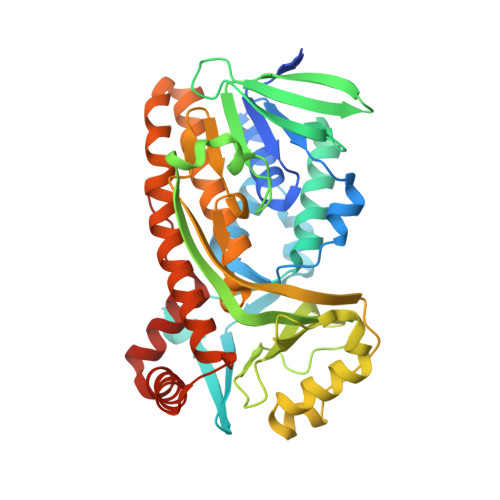Understanding the Molecular Mechanism Underlying the High Catalytic Activity ofp-Hydroxybenzoate Hydroxylase Mutants for Producing Gallic Acid.
Moriwaki, Y., Yato, M., Terada, T., Saito, S., Nukui, N., Iwasaki, T., Nishi, T., Kawaguchi, Y., Okamoto, K., Arakawa, T., Yamada, C., Fushinobu, S., Shimizu, K.(2019) Biochemistry 58: 4543-4558
- PubMed: 31639299
- DOI: https://doi.org/10.1021/acs.biochem.9b00443
- Primary Citation of Related Structures:
6JU1 - PubMed Abstract:
p -Hydroxybenzoate hydroxylase (PHBH) is a flavoprotein monooxygenase that catalyzes the hydroxylation of p -hydroxybenzoate ( p -OHB) to 3,4-dihydroxybenzoate (3,4-DOHB). PHBH can bind to other benzoate derivatives in addition to p -OHB; however, hydroxylation does not occur on 3,4-DOHB. Replacement of Tyr385 with Phe forms a mutant, which enables the production of 3,4,5-trihydroxybenzonate (gallic acid) from 3,4-DOHB, although the catalytic activity of the mutant is quite low. In this study, we report how the L199V/Y385F double mutant exhibits activity for producing gallic acid 4.3-fold higher than that of the Y385F single mutant. This improvement in catalytic activity is primarily due to the suppression of a shunt reaction that wastes reduced nicotinamide adenine dinucleotide phosphate by producing H 2 O 2 . To further elucidate the molecular mechanism underlying this higher catalytic activity, we performed molecular dynamics simulations and quantum mechanics/molecular mechanics calculations, in addition to determining the crystal structure of the Y385F·3,4-DOHB complex. The simulations showed that the Y385F mutation facilitates the deprotonation of the 4-hydroxy group of 3,4-DOHB, which is necessary for initiating hydroxylation. Moreover, the L199V mutation in addition to the Y385F mutation allows the OH moiety in the peroxide group of C-(4a)-flavin hydroperoxide to come into the proximity of the C5 atom of 3,4-DOHB. Overall, this study provides a consistent explanation for the change in the catalytic activity of PHBH caused by mutations, which will enable us to better design an enzyme with different activities.
- The Collaborative Research Institute for Innovative Microbiology , The University of Tokyo , 1-1-1 Yayoi , Bunkyo-ku, Tokyo 113-8657 , Japan.
Organizational Affiliation:






















